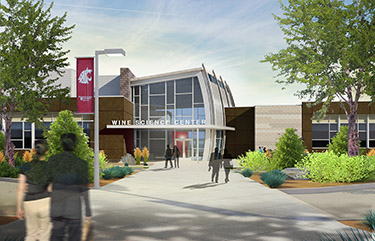|
Subscribe / Renew |
|
|
Contact Us |
|
| ► Subscribe to our Free Weekly Newsletter | |
| home | Welcome, sign in or click here to subscribe. | login |
Construction
| |
 |
November 21, 2013
Wine center will support a growing state industry
ALSC Architects

Hall
|
The Washington State wine industry is about to pop the cork on a brand new, state-of-the-art research facility.
A groundbreaking ceremony was held in September for the new Wine Science Center, a research facility located on the WSU Tri-Cities campus in Richland. The ceremony was the pinnacle of many years of preparation, organizing and fundraising led by the Washington Wine Commission and the Wine Science Center Development Authority.
The Wine Science Center will provide offices and work spaces for WSU faculty, post-doctoral researchers, graduate students, undergraduate students and staff.
The research to be conducted within the new facility will be administered under WSU’s viticulture and enology programs. This research will provide much-needed support of Washington’s burgeoning wine industry, resulting in new innovations in the processes of growing grapes and producing wine. These innovations will ensure that the Washington wine industry will continue to be good stewards of our natural resources while producing some of the finest wines in the world.
The Wine Science Center will house a unique combination of program spaces. The only other similar research facility in the U.S. is on the University of California-Davis campus.
Facilities within the 39,000-square-foot Wine Science Center will include:
• State-of-the-art research laboratories, including sensory laboratories, a wine analytical laboratory, laboratories for chemistry and plant biology microbial and molecular research, and growth chambers for vine physiology studies.
• A research and teaching winery, including a grape-processing area and large fermentation space with 192 research-scale fermentation tanks, fermenting, bottling and temperature-controlled storage.
• An international wine library.
• A teaching laboratory, classrooms, tiered sensory classroom and staff offices.
• A combination lobby/event space tied to an exterior event deck.
All about refinement
The site is located at the corner of George Washington Way and University Drive, at the northwest corner of the WSU Tri-Cities campus.
This intersection is also the gateway to the Tri-Cities Research District, creating the desire for an iconic building design that signifies arrival to both the campus and the district. The site offers a dramatic 30-foot slope down to the southwest, providing a perfect topography for a dramatic building form and a memorable sense of arrival.
The architectural design concept followed a very specific and powerful parti (organizing thought) of refinement. Wine science involves everything from the field to the bottle, so the design team elected to embrace the concept of refinement both figuratively and literally.
Anyone who experiences the building should also visually and texturally experience the building’s purpose. Whether one is changing raw data to meaningful results through research, transforming from student to professional through learning, or gaining an understanding of viticulture and enology, it’s all about refinement.
The design solution responds to the parti first by placing the lobby/event area on the upper level of the two-story facility, centered between the research wing and the classroom wing. This 2,600-square-foot space is the most visually dramatic, iconic element of the entire building, featuring 25-foot-high ceilings with curved exterior elements — structure and glass systems designed as an abstraction of an exploding wine barrel.
This space represents a gateway/portal element, linking the research district to the WSU Tri-Cities campus. Exterior views of the facility from George Washington Way feature the lobby in a very prominent manner. The view port from the lobby to the southeast provides beautiful views of the campus and region, a perspective found nowhere else.
The lobby is placed strategically within the plan to tie the building together functionally and visually. Dramatic second-floor views of the adjacent fermentation tanks on the floor below will be captivating and informative. A custom donor recognition display wall will honor and recognize key industry leaders.
A touch-screen interactive display will invite visitors to learn more about Washington’s 13 American Viticultural Areas, or AVAs. The lobby will provide important social spaces for students and faculty as well as space for gatherings of 100-plus for special wine industry or university events, all without disrupting basic building functionality.
The International Wine Library, which will feature more than 3,000 bottles of wines from Washington and around the world, has been expressed architecturally as the most refined, pristine element of the building.
Placed as if emerging from the fermentation area into the lobby, the library is wrapped in high-gloss merlot-colored skin visible from the main entrance as well as from several exterior perspectives. This simple yet bold form signifies the robust results of all of the processes contained within the facility.
Inside the library, wine is displayed as art as much as products in a library format complete with rolling ladders, additional digital displays and tables for special group gatherings.
Designed for expansion
The building form and plan directly reflect the functionality of the building programs. The tiered building form appropriately reduces the visual scale of the building and allows it to nestle into the hillside.
Lower-floor areas carved into the hillside are used for temperature-controlled storage rooms to minimize energy costs. A partial third-floor mechanical mezzanine with elevator access supports efficient HVAC duct runs and ongoing building maintenance, and ensures protection of expensive building-systems equipment.
Floor plans are designed to accommodate not only daily functions but also regular tours of the facility. Laboratories are designed with flexibility to allow long-term program growth and development. The building is also designed to expand in several directions over time.
Lastly, the site plan and building form represent a pivotal point in the evolution of the Tri-Cities campus plan. The building has been carefully placed in critical alignment with existing campus buildings to take into account future implementation of the master plan for the campus.
The building represents a key stepping stone in the refinement of the campus plan and aesthetic. The material pallet for the Wine Science Center has drawn from elements of existing campus buildings and adjacent research facilities while at the same time staying neutral enough to promote future innovations.
Exterior materials consist of a combination of smooth- and split-faced concrete masonry units woven into an ashlar pattern, flat metal panels framing fenestration at laboratories, and corrugated metal panels over utilitarian spaces.
The project is being delivered through a design-build process led by Lydig Construction and ALSC Architects. Construction of the facility will be substantially complete next summer, just in time to prepare to receive the fall grape harvest.
Rustin L. Hall is a graduate of Washington State University and is president and CEO of ALSC Architects, which has offices in Spokane and Coeur d’Alene, Idaho.
Other Stories:
- UW builds new dorms to entice students to live on campus
- UW: Top 10 capital projects
- A home away from home for Native American students
- WSU: Top 10 capital projects
- Rainier Vista bridge fulfills a long-held vision for UW campus
- A visitor center for the Facebook generation
- Apartment rehab will give students more ways to get social
- Design build cuts costs for WSU research lab
- Library overhaul was fast, cheap and efficient



